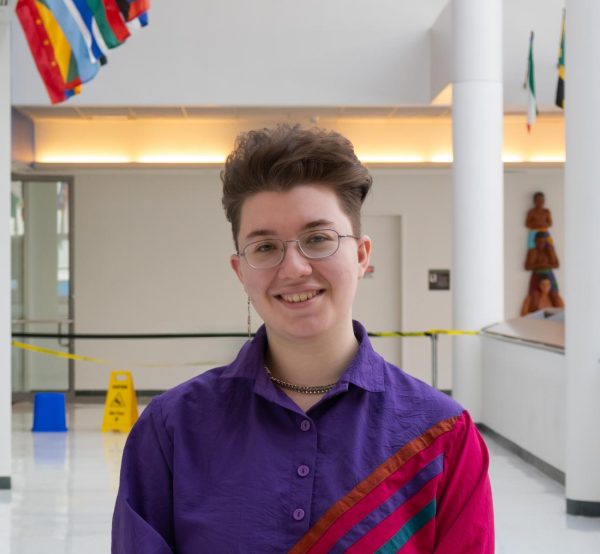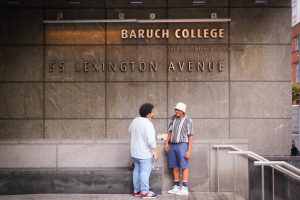The Museum at FIT’s newest exhibition is a garden of earthly delights
October 8, 2021
Banners announcing the exhibit line Manhattan’s 27th street and yet, few visitors to the Museum of FIT are likely to be prepared for what awaits them at “Ravishing: The Rose In Fashion.”
“Ravishing: The Rose In Fashion” is the institution’s first post-shutdown exhibition which opened for free admission on Aug. 6 and will run until Nov. 12.
The wall-to-floor sign in the lobby is embellished with rose stems that twist around a massive depiction of one of the more than 130 items on display from across three centuries — a V. Buso stiletto pump — and the vines that curl around the narrow stairs down to the exhibit’s entrance hint at its visual grandeur and immersivity, but to appreciate the academic ambition of its unusual organization requires stepping inside.
The exhibit is split into two galleries. In the first, a structure reminiscent of an enclosed gazebo displays rose-themed hats from a wide array of international milliners and fashion design houses on long stem-like stands, creating an indoor garden thriving under artificial light. This gallery also includes more than 75 original photographic portraits of people wearing roses dating from the 1850s to the 1920s, according to the museum. The exhibit’s webpage notes “studio and amateur photography became increasingly accessible.”
The main gallery takes the inspiration of the eponymous flower in its cultivated setting to new heights. The walls are adorned with soft projections of roses, the background music pays homage to them and the walkways are bordered by garden trellises. The gallery’s most striking aspect is the unusual way by which objects are displayed. Chronological order is eschewed in favor of sections dedicated to specific colors — red, pale pink and white, black and a “mixed bunch” of the rest — and their corresponding cultural symbolism, which is elaborated on through the exhibit’s many informational plaques.
In a way, the ethos of the exhibit itself is like a rose. If the objects on display in their stunning diversity are the blossoms, then the informational material that surrounds them like a stem provides a vital function by revealing the historical context they exist in and the intent of the designers who created them.
One of the very first signs in the exhibit reveals how it uses the symbol of the rose as a lens by which to examine and criticize society. The sign describes the inequity of the artificial flower-making industry that was prominent in major fashion cities from the 1860s to the early 1960s. In Paris it was a specialized trade nurtured through apprenticeships, but in New York and London the same product was almost universally made in sweatshop conditions by adults and children subjected to toxic dyes, heating fumes and poor lighting.
The current era may be different, but the issue of economic and environmental exploitation in the mass production of consumer clothing remains.
Each color-coded section of the second gallery builds upon the cerebral aims of the first. The museum’s website notes that the first two sections have been traditionally associated with different aspects of femininity. Red is associated with “love, passion and devotion” while white and pale pink symbolize “rites of passage — from birth through marriage” and “the loss of virginity and death.”
The representation of femininity in an industry that has traditionally viewed women as primary consumers and yet its upper levels are dominated by white men is fascinating to consider. The museum’s decision to newly acquire an ensemble by Noir Kei Ninomiya, whose clothes in their elaborate construction have already been compared to masses of blossoms, adds a new perspective to the conversation. The intricate suspension of Ninomiya’s laser-cut materials by a faux-leather harness à la Mad Max adds a bold, sensually-charged edge that the museum’s webpage says “rebuffs any notion of fragility that may be associated with the floral or the feminine.”
The red section also engages in a different kind of sociopolitical commentary with the inclusion of a Prabal Gurung dress with a sash that asks, “Who gets to be an American?” from his spring 2020 runway presentation. Considering that Gurung rose to the challenge of the Met Gala’s 2021 “In America” theme before it was even announced, it seems only fair that his work was present on its red carpet and is currently on display in the Anna Wintour Costume Center’s exhibit “In America: A Lexicon of Fashion.”
The black section has an interesting mixture of classically elegant and deliciously gothic ensembles while the mixed section reasserts the exhibit’s focus on gender by showcasing the rose in both male fashion and gender-neutral design.
New York-based independent designer Neil Grotzinger’s pieces on display feature his rejection and erotic subversion of the trappings of toxic masculinity with feminine-code materials and deliberately political employment of transparency. The museum’s website says that his collections “explore notions of masculinity, queerness, power, and sensuality.”
Gender roles, much like artificial roses, boast the illusion of naturalness that hide the effort and purpose behind their construction and maintenance. But as the rights of ordinary transgender and gender-nonconforming people continue to be under attack, it remains to be seen whether the mainstream fashion industry’s sudden interest in androgyny is ultimately a regressive, voyeuristic fixation on perceived “oddity” or a sign that the dream of a world in which marginalized people can safely and joyfully express themselves is drawing closer to reality.
Ultimately, “Ravishing: The Rose In Fashion” embraces the academic scrutiny of fashion due to the involvement of three accomplished fashion historians: Valerie Steel, director and chief curator of MFIT and co-curators Amy de la Haye, professor at London College of Fashion and MFIT curator Collen Hill. The in-person exhibit was accompanied by a virtual symposium held on April 30 composed of five talks that can be viewed on MFIT’s YouTube channel and the publication by Yale University Press of a book bearing the same name written by de la Haye.
New Yorkers should not deprive themselves of the chance to see it in person, especially not Baruch students, for whom the MFIT is only a 15-minute walk away from campus.








